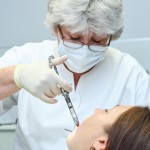
The effects of dental local anaesthetic often prolonged, particularly soft tissue numbness. This may affect appearance, the ability to speak, smile or eat following dental treatment. Phentolamine mersylate has been shown to accelerate the return of soft tissue feeling after routine dental procedures and was licensed by The Food and Drugs Administration for dental use in 2008. The main aim of this study as to compare the reversal of pulpal and soft tissue anesthesia when phentolamine was administered at 30 minutes versus 60 minutes after the administration of an inferior alveolar nerve (IAN) block.
90 patients received two sets of injections at least one week apart. One set consisted of an IAN block by using a cartridge of 2% lidocaine with 1:100,000 epinephrine plus an injection of a cartridge of phentolamine given 30 minutes after the IAN block, followed by a sham injection given at 60 minutes. The second set of injections consisted of an IAN block by using a cartridge of 2% lidocaine with 1:100,000 epinephrine plus a sham injection given 30 minutes after the IAN block, followed by an injection of a cartridge of phentolamine given at 60 minutes. Injection site was chosen randomly for the first set with second set being given on the same side. Experimental teeth and contralateral canine were tested at baseline with a pulp tested, which was also used to measure depth of pulpal anaesthesia. Pain for needle insertion, needle placement, and solution deposition was recorded by using a visual analogue scale (VAS). Patients subjectively assessed lip numbness at 20-minute intervals and recorded when normal sensation returned. Patients completed post injection surveys after each appointment.
- Significant differences (P < .05) were shown for return-to-normal sensation for the lip and tongue when the phentolamine was administered at 30 minutes compared with 60 minutes. The mean time difference being 24 minutes for lip and 27 for tongue.
- The most common reported post operation complications were initial tenderness (4%–6%), headache (2%–4%), and soreness on opening the jaw (3%) in the area of the injection.
The authors concluded
Phentolamine would be beneficial for patients who would like to experience a faster return to normal soft tissue function and sensation after the administration of local anesthesia. However, because pulpal anesthesia is also reversed fairly rapidly, phentolamine should be administered at the end of the dental appointment.
Links
Elmore S, Nusstein J, Drum M, Reader A, Beck M, Fowler S. Reversal of Pulpal and Soft Tissue Anesthesia by Using Phentolamine: A Prospective Randomized, Single-blind Study. J Endod. 2013 Apr;39(4):429-34.
